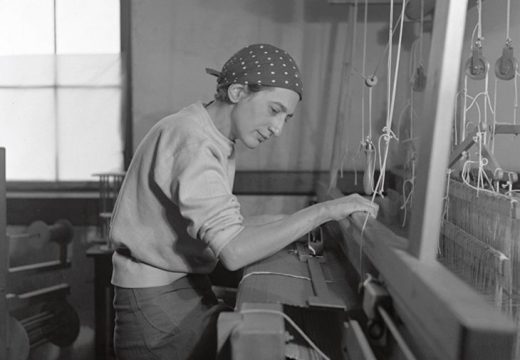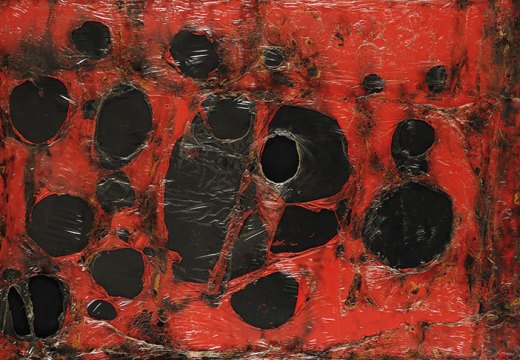A cauldron of cloud forms at sunrise in Ulassai, birthplace of Sardinian artist Maria Lai (1919–2013). Dog barks echo across the valley and the soft chimes of goat bells thread through the fog. The town, which Lai in her later years turned into an outdoor art gallery, clings to the flanks of the Ogliastra mountains, overlooked by sheer yellow cliffs and outlandish stone pines. At its edges, large boulders left by landslides line steeply snaking roads, and flood channels sluice off hairpin bends. Houses are constructed of stone and slate, thick walls heavily plastered for insulation. In this harsh landscape, people are solicitous of each other; greetings ring out – buongiorno, salve, ciao.
I first came across Maria Lai at the Venice Biennale in 2017. Her work was new to me but spoke in ways that required no translation. The tail ends of an illegible script embroidered onto a book fell from between its pages in a soft black halo. On one wall hung an enormous piece of white fabric, overlapping projections of globes track-stitched across its surface in umber thread. Strange topographies warped lines of latitude and longitude which resolved into snarls and pendant knots. More astrolabe than map, it was loose and precise, strange and bracing, implying distance, precision and speed. From bread and thread, women’s rough materials, her art told stories that overflowed boundaries and occupied space, suggesting the very limits and extent of human knowledge.
The connections between stories, knowledge and art were made early by Lai. As a girl she used to drop string on the ground and make up tales according to the pattern – but she struggled at school until her teacher, Sardinian writer Salvatore Cambosu, encouraged her to read purely for the rhythm of the writing. If meaning could be conveyed non-semantically, it could also be expressed through movement, objects, marks. She already saw how the non-written world could be read; the written word now opened up.
Lai went on to study at the Liceo Artistico in Rome and the Accademia di Belle Arti in Venice before returning to Sardinia. She exhibited in Cagliari and in 1957 held her first show in Rome, curated by Marcello Venturoli at the fashionable Galleria L’Obelisco. It was well received but a 10-year spell of depression followed, during which time she refused to exhibit and instead produced pencil and watercolour studies of Sardinian women at work.
A few are on show at an exhibition at the Stazione dell’Arte, a gallery housed in Ulassai’s defunct train station now dedicated to her art. Lai depicts women kneading bread, baking, carrying baskets. Her palette ranges from slate to wheat and her lines are purposeful, conveying the force and choreography of movements passed down through generations of women. The extent of her education and artistic standing exempted her from this kind of life but she embraced it for its myths, songs, stories, gossip, and histories. A long, white-clothed table at the centre of the show is laid with terracotta-baked books and loaves of bread inscribed with script and impressed with leaves. The message along its embroidered runner begins: Quando un libro è cosa viva bisogna mangiarlo (‘When a book is a living thing, it must be eaten’). Knowledge of books and of bread occupy the same place at the table; both are offered up as art. The exhibition is one of a number taking place around Italy to celebrate the centenary of Lai’s birth.

Installation view of Pane Quotidiano, Maria Lai. Photo: Arasolè; courtesy Fondazione Stazione dell’Arte
Up the road, at her tomb, a handful of names recur throughout the graveyard – Contu, Lai, Serra, Chilotti, Puddu, Pilia. In the afternoon, old men gather to drink and play cards at a bar which, like both graveyard and gallery, looks out and down the valley. In a town governed by ritual, repetition and regularity, Lai’s work combines local traditions with contemporary artistry. One of her loom sculptures occupies the ceiling of the disused grain wash house. The school playground is decorated with a game of her design. Concrete road-side murals depicting goats hail drivers of tiny beaten Fiats and cross-island buses in and out of town. Directly above one is a weaving cooperative, Su Marmuri, to which Lai donated a number of works. Four women wearing ear protectors bend over 100-year-old looms, picking threads through the warp with deft, swift motions. A long rug near completion rolls under the loom’s body, and cushion covers bearing Lai’s distinctive goats emerge in lines of black Sardinian wool.
Her best-known work, Legarsi alla Montagna (Bind to the Mountain), which took place in 1981 in Ulassai, was inspired by the local tale of a girl who escaped a mountain landslide by following the vision of a blue ribbon. Over a single day each house was tied to its neighbours with strips of blue cloth and a final piece attached to the mountain overlooking the town. For Lai the ribbon symbolised the hope and salvation offered by art, imagination and play, but its consequences were real. Having initially foundered amid long-standing feuds, the intervention was rescued when a group of townswomen took it upon themselves to dispel the rancour and make the project happen. An air of celebration suffuses the film documenting the day, which is on show at the gallery. Vast swathes of cloth are torn up in a sunbaked square, women in black and men in caps roll up strips as if gleaning after harvest, and children throw spools into the air with delight. The ribbon that festooned the town overran its original story – Lai’s art literally bound Ulassai together.
Unlimited access from just $16 every 3 months
Subscribe to get unlimited and exclusive access to the top art stories, interviews and exhibition reviews.
















![Masterpiece [Re]discovery 2022. Photo: Ben Fisher Photography, courtesy of Masterpiece London](http://www.apollo-magazine.com/wp-content/uploads/2022/07/MPL2022_4263.jpg)
It’s time for the government of London to return to its rightful home